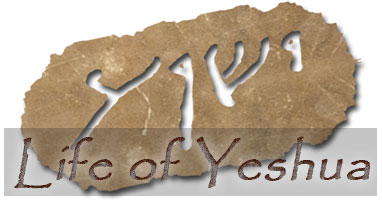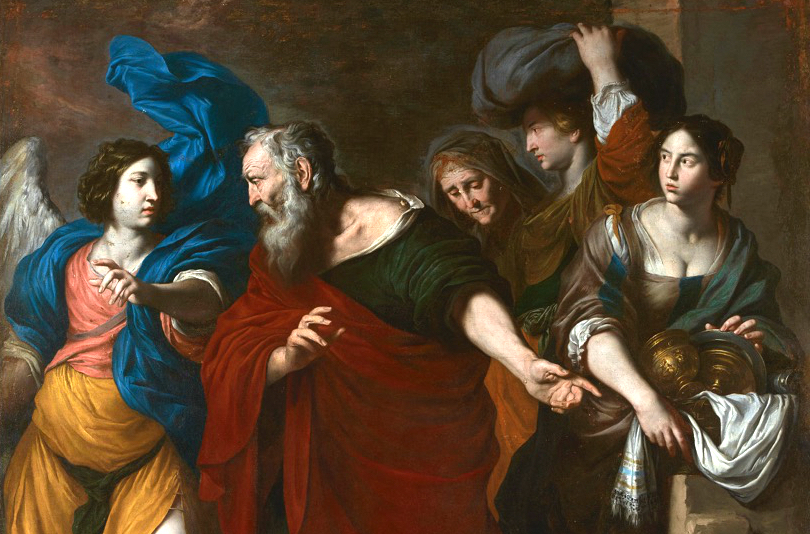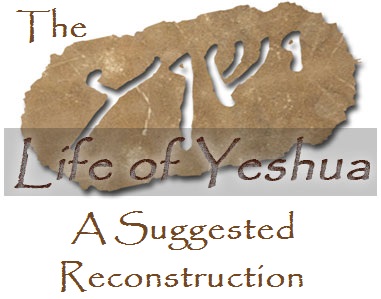Matt. 10:39; 16:25; Mark 8:35; Luke 9:24; 17:33
(Huck 62, 123, 184; Aland 103, 160, 235;
Crook 118, 178, 262, 287)[41]
Updated: 12 April 2023
מִי שֶׁיְּבַקֵּשׁ לְמַלֵּט אֶת נַפְשׁוֹ יְאַבְּדֶהָ וּמִי שֶׁיְּאַבֵּד אֶת נַפְשׁוֹ יְקַיְּמֶהָ
“Whoever wants to preserve his life when the calamity strikes will have to destroy his attachment to possessions, but whoever does forsake his possessions will live to see another day.[42]
| Table of Contents |
|
3. Conjectured Stages of Transmission 5. Comment 8. Conclusion |
Reconstruction
To view the reconstructed text of Preserving and Destroying click on the link below:
Premium Members and Friends of JP must be signed in to view this content.
If you are not a Premium Member or Friend, please consider registering. Prices start at $5/month if paid annually, with other options for monthly and quarterly and more: Sign Up For Premium
Conclusion
In Preserving and Destroying Jesus continued his use of the story of Lot’s flight from Sodom to illustrate how his contemporaries should behave when war with the Roman Empire erupts. According to Jewish tradition, Lot’s hesitation over his belongings nearly proved fatal to himself, his wife and his daughters. From Lot’s example Jesus warned the members of his generation to forsake their possessions and run if they wanted to survive the onslaught of the Roman legions.
 Click here to return to The Life of Yeshua: A Suggested Reconstruction main page.
_______________________________________________________
Click here to return to The Life of Yeshua: A Suggested Reconstruction main page.
_______________________________________________________
- [1] The Hebrew reconstruction appears in Menahem Kister, “Plucking on the Sabbath and Christian-Jewish Polemic,” Immanuel 24/25 (1990): 35-51, esp. 42 n. 25. The English translation of his reconstruction is our own. ↩
- [2] Scholars approaching the question from the perspective of Markan Priority generally conclude that the author of Luke injected Preserving and Destroying into the Son of Man materials found in Luke 17. See Kloppenborg, 158-159. Bovon (2:514), while regarding Luke 17:33 as an insertion, noted that such insertions were a departure from the author of Luke’s usual habit of concentrating on one source at a time. ↩
- [3] On Anth.’s block of Son of Man material in Luke 17, see Days of the Son of Man, under the subheading “Story Placement.” ↩
- [4] It appears to be the author of Matthew who separated the Darnel Among the Wheat parable from the Bad Fish Among the Good parable. Likewise, it was the author of Luke who separated the Persistent Widow parable from Friend in Need. ↩
- [5] So, for example, the Anthologizer attached Like Children Complaining to the end of a discourse unit about John the Baptist (see the introduction to the “Yohanan the Immerser and the Kingdom of Heaven” complex), and he attached Woes on Three Villages to the end of the Sending the Twelve discourse (see Woes on Three Villages, under the subheading “Story Placement”). ↩
- [6] We have found one example of the Anthologizer's injection of a pericope into the middle of a block: attaching the Father and Son saying to Yeshua’s Thanksgiving Hymn in the middle of a block pertaining to the return of the apostles from their healing and teaching mission. However, this is an exception that proves the rule. It is clear why the Anthologizer attached Father and Son to Yeshua’s Thanksgiving Hymn: the two pericopae have similar themes and vocabulary (father-son relationship, revelation). Preserving and Destroying, on the other hand, does not share obvious themes or vocabulary with Lesson of Lot’s Wife or Indiscriminate Catastrophe that would have led the Anthologizer to attach Preserving and Destroying to either pericope.
See Yeshua’s Thanksgiving Hymn, under the “Story Placement” subheading, for a discussion of the Anthologizer’s insertion of Father and Son following Yeshua’s Thanksgiving Hymn. ↩ - [7] The author of Luke did occasionally inject foreign pericopae into large blocks of material inherited from an earlier source. Thus, the author of Luke injected Mysteries of the Kingdom of Heaven into a block of material otherwise taken from FR. See the introduction to the “Four Types of Hearers” complex and Mysteries of the Kingdom of Heaven, under the “Story Placement” subheading. Likewise, the author of Luke injected Pharisees Reject God’s Purpose (Luke 7:29-30) into a block of material otherwise taken from Anth. See the introduction to the “Yohanan the Immerser and the Kingdom of Heaven” complex. ↩
- [8] Cf. Manson (Sayings, 145), who concluded that Luke 17:33 represents the “Q” location of Preserving and Destroying. ↩
- [9] There is a rabbinic wordplay on וַיִּתְמַהְמָהּ (vayitmahmāh, “and he lingered”; Gen. 19:16) and תִּמָּהוֹן (timāhōn, “hesitation”). ↩
- [10] In the version of this tradition found in Yalkut Shim‘oni §84 the text reads במה אברר (“What should I pick?”) instead of כמה אבוד (“What destruction!”) as in Gen. Rab. 50:11. The two versions are graphically similar and both make sense in context. ↩
- [11] For the angels’ rebuke of Lot in its larger context, see Lesson of Lot’s Wife, Comment to L3. ↩
- [12] Instances of נֶפֶשׁ with the meaning “desire” occur in Biblical and Mishnaic Hebrew. In the Hebrew Scriptures we read:
וְהָיָה אִם־לֹא חָפַצְתָּ בָּהּ וְשִׁלַּחְתָּהּ לְנַפְשָׁהּ
And it will be that if you no longer desire her [i.e., a woman captured in battle—DNB and JNT], you must send her away according to her desire [לְנַפְשָׁהּ; i.e., wherever she wishes to go—DNB and JNT]. (Deut. 21:14; cf. Jer. 34:16)
וַיְנַסּוּ אֵל בִּלְבָבָם לִשְׁאָל אֹכֶל לְנַפְשָׁם
And they tested God in their heart, asking for food according to their desire [לְנַפְשָׁם; LXX: ταῖς ψυχαῖς αὐτῶν]. (Ps. 78:18)
The example from Psalm 78 shows that the LXX translators did not always understand the intended nuance of נֶפֶשׁ, or at least they did not know how to represent this meaning of נֶפֶשׁ in Greek. Whereas in Hebrew it is understood that the Israelites tested God by demanding foods they craved, in the Greek translation it appears that the Israelites simply asked for food to stay alive.
In Mishnaic Hebrew, too, נֶפֶשׁ can mean “desire.” See Jastrow, 926-927. Some examples of this usage are found in the following midrashic text:לפי שנתן דוד נפשו עליו לבנותו נקרא על שמו...וכן אתה מוצא שכל דבר שאדם נותן נפשו עליו נקרא על שמו
Because David set his desire [נָתַן דָּוִד נַפְשׁוֹ; lit., David gave his soul] on building it [i.e., the Temple—DNB and JNT], it was called by his name.... And so you find that everything upon which a person sets his desire [אָדָם נוֹתֵן נַפְשׁוֹ] is called by his name. (Mechilta de-Rabbi Ishmael, Shirata §1 [ed. Lauterbach, 1:170])
- [13] It was precisely because he understood Preserving and Destroying to be a paradox that Bundy (390 §300) declared that Preserving and Destroying “breaks into the continuity of the discourse.” According to Bundy, Preserving and Destroying contradicts the advice given in Lesson of Lot’s Wife to abandon one’s property, since according to his paradoxical interpretation of Jesus’ saying, any effort to save one’s life (such as taking flight) results in its forfeiture. Our Hebraic approach to Preserving and Destroying, on the other hand, does not contradict but reinforces Lesson of Lot’s Wife and continues with the theme of Lot’s departure from Sodom. ↩
- [14] Cf. Joachim Jeremias, Unknown Sayings of Jesus (trans. Reginald H. Fuller; 2d ed.; London: SPCK, 1964), 77-78. Because of Jeremias’ unfortunate method of Scripture citation, in which he gave only the first verse + “f.” to indicate a pericope (e.g., Luke 17.31f.), it is impossible to know whether Jeremias considered Luke 17:33 to be an organic part of Lesson of Lot’s Wife. It would make sense if he had, given that he discusses an extra-canonical saying attributed to Jesus (σῴζου σὺ καὶ ἡ ψυχή σου [“Save yourself and your soul”]; Clement of Alexandria, Excerpta ex Theodoto 2:2) which more closely resembles Preserving and Destroying (Luke 17:33) than Lesson of Lot’s Wife (Luke 17:31-32). ↩
- [15] See Robert L. Lindsey, “From Luke to Mark to Matthew: A Discussion of the Sources of Markan ‘Pick-ups’ and the Use of a Basic Non-canonical Source by All the Synoptists,” under the subheading “Sayings Doublets”; idem, TJS, 36-37. ↩
- [16] On the small collections of sayings we refer to as “strings of pearls” scattered about in Luke’s Gospel as stemming from FR, see LOY Excursus: Sources of the “Strings of Pearls” in Luke’s Gospel. ↩
- [17] On the author of Matthew’s construction of the Matthean version of the Sending the Twelve Discourse, see the introduction to the “Mission of the Twelve” complex. ↩
- [18] It is possible that ψυχή (“soul”) was a catchword that led to the lumping together of the FR versions of Demands of Discipleship (Luke 9:23), Preserving and Destroying (Luke 9:24), and the saying in Luke 9:25, which Lindsey believed was a paraphrase of the point of the Rich Fool parable. Although the term ψυχή does not appear in Luke 9:23 or Luke 9:25, ψυχή does appear in the Anth. parallels to these verses (Luke 14:26-27 ∥ Luke 9:23; Luke 12:20 ∥ Luke 9:25) (see LOY Excursus: Sources of the “Strings of Pearls” in Luke’s Gospel, under the subheading “Lukan Doublets”). In that case, the First Reconstructor drew these sayings together because they included the word ψυχή in Anth., but when the First Reconstructor paraphrased these sayings he was not concerned to preserve the word ψυχή, which had been the catalyst for bringing them together. ↩
- [19] See Yeshua, His Mother and Brothers, Comment to L19. ↩
- [20] See Yeshua, His Mother and Brothers, Comment to L19. ↩
- [21] Pace Bovon, 2:522. ↩
- [22] Pace Nolland (Luke, 2:861), who attributed the verbal differences of Luke 17:33 from the wording in Luke 9:24 ∥ Mark 8:35 to Lukan redaction. ↩
- [23] On σῴζειν as an FR redactional term, see Four Soils Interpretation, Comment to L34. ↩
- [24] See Hatch-Redpath, 2:1125. ↩
- [25] Bridge, in his discussion of Lesson of Lot’s Wife, noted the high frequency of references to “saving” a “soul” that occurs in the story of Lot and his family’s escape from Sodom. See Steven L. Bridge, ‘Where the Eagles are Gathered’: The Deliverance of the Elect in Lukan Eschatology (Sheffield: Sheffield Academic Press, 2003), 46. ↩
- [26] See Dos Santos, 113. ↩
- [27] Cf. Kister’s reconstruction of Preserving and Destroying quoted in the Reconstruction section above. ↩
- [28] The LXX translation of Ezek. 22:27 lacks a Greek equivalent to the phrase לְאַבֵּד נְפָשׁוֹת (le’abēd nefāshōt, “to destroy souls”). ↩
- [29] Cf. Bundy, 390 §300; Bovon, 2:522. ↩
- [30] Cf. Bultmann, 93; Collins, 409. ↩
- [31] Cf. Taylor, 382. ↩
- [32] See LOY Excursus: Catalog of Markan Stereotypes and Possible Markan Pick-ups, under the entry for Mark 1:1. ↩
- [33] See Hatch-Redpath, 1:601. ↩
- [34] See Jastrow, 454. ↩
- [35] Examples of חִיָּה in the sense of “resurrect” or “bring [back] to life” occur in phrases from the Amidah, such as מְחַיֵּה מֵתִים אַתָּה רַב לְהושִׁיעַ (“Restorer of the Dead, you are mighty to save”) and מֶלֶךְ מֵמִית וּמְחַיֶּה וּמַצְמִיחַ יְשׁוּעָה (“O king, who kills and restores to life and causes salvation to sprout forth”). ↩
- [36] A blessing recited on holy days demonstrates the subtle difference between the use of הֶחֱיָה (“cause to live”) and קִיֵּם (“keep alive,” “preserve”) in Mishnaic Hebrew: בָּרוּךְ אַתָּה יי אֱלֹהֵנוּ מֶלֶךְ הָעוֹלָם שֶׁהֶחֱיָנוּ וְקִיְּמָנוּ וְהִגִּיעָנוּ לַזְּמַן הָזֶּה (“Blessed are you, O LORD, our God, king of the universe, who has given us life [שֶׁהֶחֱיָנוּ], and preserved us [וְקִיְּמָנוּ], and brought us to this season”). ↩
- [37] On reading יקימה as a pi‘el verb (“he will preserve it”) rather than as a hif‘il (“he will raise it”), see Jan Joosten and Menahem Kister, “The New Testament and Rabbinic Hebrew,” in The New Testament and Rabbinic Literature (Reimund Bieringer; Florentio García Martinez, Didier Pollefeyt and Peter J. Tomson, eds.; Leiden: Brill, 2010), 335-350, esp. 341-342. ↩
- [38]
Preserving and Destroying Luke’s Anth. Version Anthology’s Wording (Reconstructed) ὃς ἐὰν ζητήσῃ τὴν ψυχὴν αὐτοῦ περιποιήσασθαι ἀπολέσει αὐτήν ὃς δ᾿ ἂν ἀπολέσῃ ζῳογονήσει αὐτήν ὃς ἐὰν ζητήσῃ τὴν ψυχὴν αὐτοῦ περιποιήσασθαι ἀπολέσει αὐτήν ὃς δ᾿ ἂν ἀπολέσῃ τὴν ψυχὴν αὐτοῦ ζῳογονήσει αὐτήν Total Words: 15 Total Words: 18 Total Words Identical to Anth.: 15 Total Words Taken Over in Luke: 15 Percentage Identical to Anth.: 100.00% Percentage of Anth. Represented in Luke: 83.33% .
Preserving and Destroying Luke’s FR Version Anthology’s Wording (Reconstructed) ὃς γὰρ ἂν θέλῃ τὴν ψυχὴν αὐτοῦ σῶσαι ἀπολέσει αὐτήν ὃς δ᾿ ἂν ἀπολέσῃ τὴν ψυχὴν αὐτοῦ ἕνεκεν ἐμοῦ οὗτος σώσει αὐτήν ὃς ἐὰν ζητήσῃ τὴν ψυχὴν αὐτοῦ περιποιήσασθαι ἀπολέσει αὐτήν ὃς δ᾿ ἂν ἀπολέσῃ τὴν ψυχὴν αὐτοῦ ζῳογονήσει αὐτήν Total Words: 22 Total Words: 18 Total Words Identical to Anth.: 14 Total Words Taken Over in Luke: 14 Percentage Identical to Anth.: 63.64% Percentage of Anth. Represented in Luke: 77.78% ↩
- [39]
Preserving and Destroying Mark’s Version (FR via Luke) Anthology’s Wording (Reconstructed) ὃς γὰρ ἐὰν θέλῃ τὴν ἑαυτοῦ ψυχὴν σῶσαι ἀπολέσει αὐτήν ὃς δ᾿ ἂν ἀπολέσει τὴν ψυχὴν αὐτοῦ ἕνεκεν ἐμοῦ καὶ τοῦ εὐαγγελίου σώσει αὐτήν ὃς ἐὰν ζητήσῃ τὴν ψυχὴν αὐτοῦ περιποιήσασθαι ἀπολέσει αὐτήν ὃς δ᾿ ἂν ἀπολέσῃ τὴν ψυχὴν αὐτοῦ ζῳογονήσει αὐτήν Total Words: 24 Total Words: 18 Total Words Identical to Anth.: 13 Total Words Taken Over in Mark: 13 Percentage Identical to Anth.: 54.17% Percentage of Anth. Represented in Mark: 72.22% ↩
- [40]
Preserving and Destroying Matthew’s Version (Anth.) Anthology’s Wording (Reconstructed) ὁ εὑρὼν τὴν ψυχὴν αὐτοῦ ἀπολέσει αὐτήν καὶ ὁ ἀπολέσας τὴν ψυχὴν αὐτοῦ ἕνεκεν ἐμοῦ εὑρήσει αὐτήν ὃς ἐὰν ζητήσῃ τὴν ψυχὴν αὐτοῦ περιποιήσασθαι ἀπολέσει αὐτήν ὃς δ᾿ ἂν ἀπολέσῃ τὴν ψυχὴν αὐτοῦ ζῳογονήσει αὐτήν Total Words: 17 Total Words: 18 Total Words Identical to Anth.: 9 Total Words Taken Over in Matt.: 9 Percentage Identical to Anth.: 52.94% Percentage of Anth. Represented in Matt.: 50.00% .
Preserving and Destroying Matthew’s Version (FR via Mark) Anthology’s Wording (Reconstructed) ὃς γὰρ ἐὰν θέλῃ τὴν ψυχὴν αὐτοῦ σῶσαι ἀπολέσει αὐτήν ὃς δ᾿ ἂν ἀπολέσῃ τὴν ψυχὴν αὐτοῦ ἕνεκεν ἐμοῦ εὑρήσει αὐτήν ὃς ἐὰν ζητήσῃ τὴν ψυχὴν αὐτοῦ περιποιήσασθαι ἀπολέσει αὐτήν ὃς δ᾿ ἂν ἀπολέσῃ τὴν ψυχὴν αὐτοῦ ζῳογονήσει αὐτήν Total Words: 21 Total Words: 18 Total Words Identical to Anth.: 15 Total Words Taken Over in Matt.: 15 Percentage Identical to Anth.: 71.43% Percentage of Anth. Represented in Matt.: 83.33% ↩
- [41] For abbreviations and bibliographical references, see “Introduction to ‘The Life of Yeshua: A Suggested Reconstruction.’” ↩
- [42] This translation is a dynamic rendition of our reconstruction of the conjectured Hebrew source that stands behind the Greek of the Synoptic Gospels. It is not a translation of the Greek text of a canonical source. ↩





